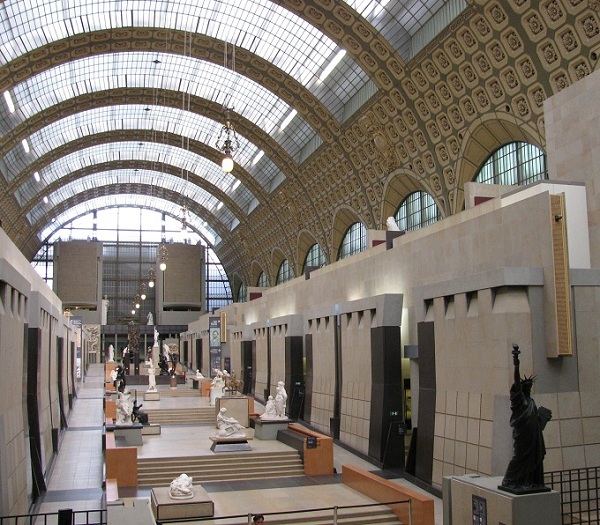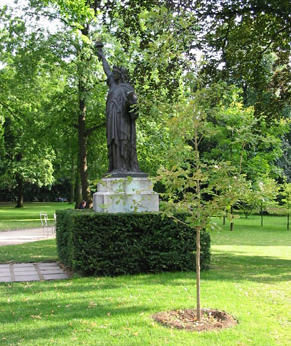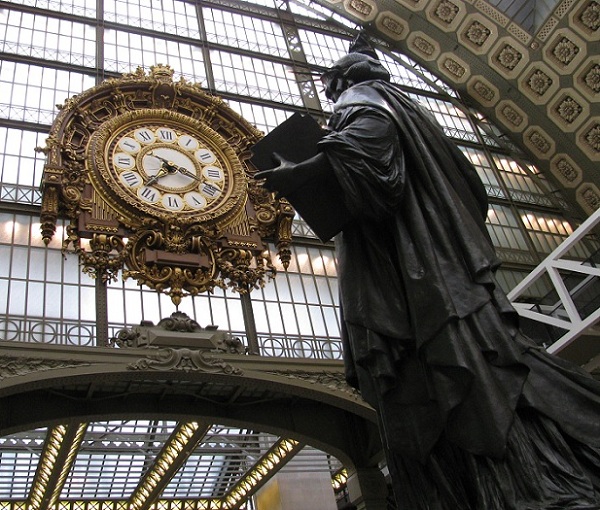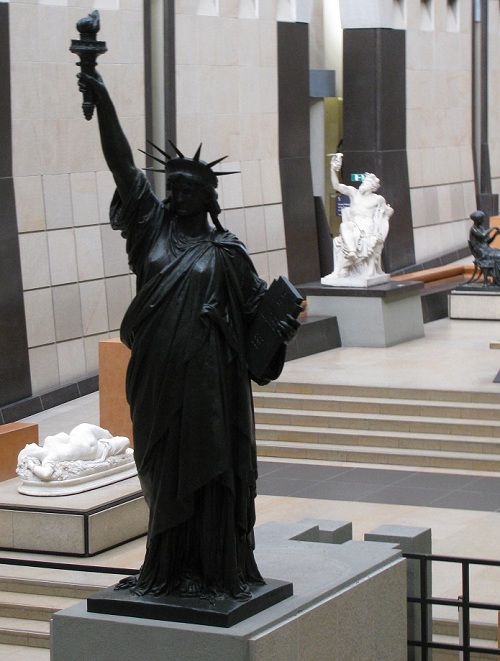
July 2012 – Joining Whistler’s Mother, Van Gogh’s Self-portrait, Degas’s ballerinas, and many more, the Musée d’Orsay took on another familiar face this month when Liberty was given place of honor on a pedestal near the entrance to the museum’s great nave.
The Orsay Museum had long claimed that Liberty rightfully belonged within its walls rather than in the Luxembourg Garden, where it previously stood, since it is heir to the collection of work from that period at the Luxeumbourg Museum, where the French State had originally planned to show this 1899 nine-foot version of Auguste Bartholdi colossal statue in New York Harbor.

Bartholdi (1834-1904) himself had ordered the casting of this 1/16 scale version. It was initially displayed at Paris’s Universal Exhibition of 1900, the same world’s fair that saw the construction of the Grand and Petit Palais. At Bartholdi’s request, the French State purchased the statue by paying only the casting cost, with the intention of placing it in the Luxembourg Museum, the oldest museum open to the public in France (1750), located on the edge of the Luxembourg Garden.

Soon, however, the statue got sidetracked.
For lack of room inside the museum, which then had a significant permanent collection of art and sculpture, and to make it more visible, Liberty was placed in the Luxembourg Garden in 1906. It remained there until 2011.
The national collections from the Luxembourg Museum, a space now dedicated to high-quality temporary exhibitions, have since moved to the Louvre and the Orsay, hence the Orsay’s claim to Liberty.
Nevertheless, the French Senate, overseers of the hallowed ground of Left-Bank well-being that is the Luxembourg Garden, was reluctant to give up one of its prized possessions. Liberty’s position in the Senate’s backyard was further underscored in 2002 when an American oak, a gift of the American community in Paris, was planted nearby in commemoration of the attacks of September 11, 2001.

Liberty began its trip to the Orsay Museum last fall when the French Senate finally approved its transfer from the Luxembourg Garden. Senatorial elections of September 2011 gave a majority to the Socialist Party and its allies for the first time in that body’s history. The desire of newly elected Senate President Jean-Pierre Bel to settle the old dispute about the statue’s rightful place wasn’t necessarily due to a question of left-right politics since it was likely also influenced by vandalism in the garden, most recently the theft of Liberty’s gilt flame.
The statue was restored thanks to funding by from the American Friends of the Musée d’Orsay (AFMO), including a recasting of the flame. The AFMO is “dedicated to raising public awareness and financial support for the Musée d’Orsay and Musée de l’Orangerie.”
A new casting will eventually be placed in the Luxembourg Garden where Bartholdi’s casting was, so the American oak by the empty pedestal won’t look so lonely.
The black Statue of Liberty (“La Liberté éclairant le monde,” by its original French name, “Liberty Enlightening the World”) was inaugurated in its new home on July 2, 2012 in the presence of…

… left to right in the photo above: AFMO co-chairs Peter J. Solomon and Susan Solomon, American Ambassador to France Charles H. Rivkin, AMFO chair Susan M. Tolson, Senate President Jean-Pierre Bel, and the president of the Orsay and Orangerie Museums Guy Cogeval.

Liberty’s tablet, which in its American version reads “JULY IV MDCCLXXVI,” reads in its Orsay version “15 DE NOVEMBRE 1889,” the date on which the 1/8 scale version on the Ile aux Cygnes, an island just beyond the Eiffel Tower, was inaugurated. The year 1889 also commemorates the centennial of the French Revolution.
Information about and images of the Ile aux Cygnes version and other Liberty’s in Paris can be found here.

As to the American version, the full-scale statue overlooking New York Harbor was created as a gift from the fairly young Third Republic of France to honor the centennial of the United States of America in 1876. Bartholdi and friends were already working on the idea during the final years of Emperor Napoleon III’s reign as a form of artistic opposition to the lack of democracy during the emperor’s reign. France made a painful transition from the imperial rule of Napoleon III to the democratic Third Republic during and following the Franco-Prussian War of 1870-1871. However, it took a while for the project to get legs both metaphorically and physically. The colossal version was finally dedicated in New York Harbor in 1886.
© 2012, Gary Lee Kraut

